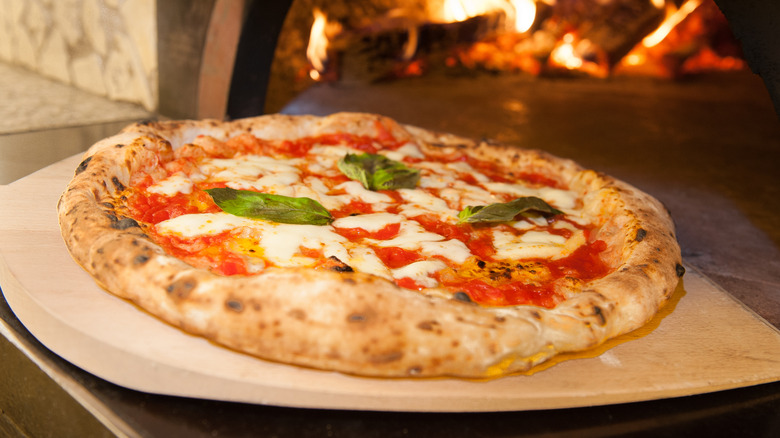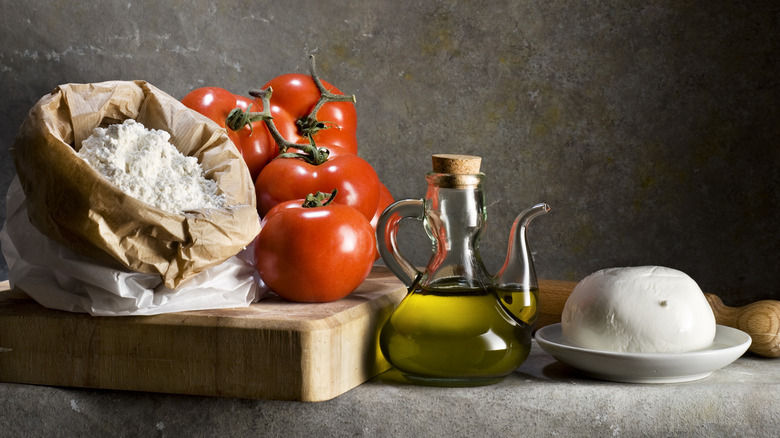What Is Margherita Pizza And How Is It Different From Regular Cheese?
To the casual observer, it can be easy to mistake Margherita pizza for a plain cheese pie. And given the two styles' similarities, it makes to think of them as one and the same. Both varieties use very few ingredients and include pizza dough, sauce, and mozzarella cheese. Because of their simple recipes, both dishes focus more on the quality of each component rather than adventurous flavor combinations. But despite these shared qualities, Margherita pizza is an entirely unique dish from cheese pizza. The two pizzas are certainly delicious, but there's a historic, elevated element to Margherita not inherent to its cheesy cousin.
Food historians aren't entirely sure about the true origins of Margherita pizza, but there is a popular tale many attribute to its creation. The story goes that in 1889, an Italian pizza maker named Raffaele Esposito was tasked with making three pizzas for Queen Margherita. Two of the pizzas weren't big hits, but the third one was special. Its main ingredients, mozzarella cheese, tomatoes, and basil, reflected the Italian flag's colors. Queen Margherita loved the pizza, so it was named in her honor. While the voracity of that story is up for debate, there's no question that the Margherita pizza is still an Italian classic.
What makes a margherita pizza special
A pizza must meet a rigid set of rules in order to officially be a "Margherita" pizza, which is what makes the style so unique. The first requirement is the use of fresh mozzarella cheese. Compared to processed shredded mozzarella, fresh mozzarella is much creamier due to being stored in liquid. For a really authentic pie, use mozzarella di bufala, or buffalo mozzarella. Most run-of-the-mill cheese pizzas don't use fresh cheese, and there aren't any set rules for what kinds of cheese they should be topped with.
Margherita pizza also features a hearty helping of sauce. This sauce can be imbued with spices, but plain, high-quality blended tomatoes work just as well. Most recipes will either call for fresh tomatoes, or San Marzano tomatoes that come in a can. This is a Neoplitan-style pizza, which means the sauce is the star of the show. Regular cheese pizzas certainly have their share of delicious sauce, but not nearly as much as Margherita pizzas. Unlike cheese pizzas, Margherita pizzas are always topped with a few fresh basil leaves. Other than sauce, cheese, and basil, Margherita slices may have some olive oil and salt, but that's it.
Margherita pizzas are cooked in a flash
Cheese pizzas can be made with any type of flour, such as whole wheat, but Margherita pizzas are traditionally made with fine 00 flour. This flour creates a pillowy, delicate dough that turns into a flaky, crispy crust. Margherita pizzas cook fast. If you're lucky enough to have a proper wood-burning pizza oven, they can cook in as little as twenty seconds. To cook the pizza in your oven, you'll have to bake it for around six minutes at the oven's highest setting.
A final difference between cheese and Margherita pizzas is size. The moisture from the sauce and the mozzarella can create a bit of a soupy pool in the middle of the pie. To minimize this, Margherita pizzas and other Neapolitan varieties are usually less than a foot in diameter — much smaller than the large cheese pizza you might buy from your local pizza chain, and small enough so that the crust won't crumble under the weight of the toppings. Generally speaking, a cheese pizza can be used to describe many different pizzas, from deep dish to thin crust. But while Margherita pizzas may technically be cheese pizzas, certainly not all cheese pizzas are Margheritas.


